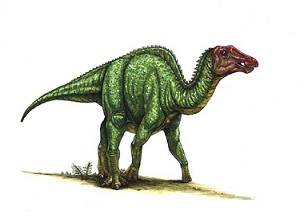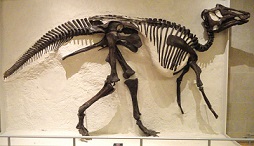
Prosaurolophus often simply referred to as Prosaurolophus, is a fascinating Dinosaur from the Late Cretaceous period, approximately 76 to 73 million years ago. This 500-word exploration will delve into its classification, physical characteristics, habitat, behavior, and its significance in the world of paleontology.
Prosaurolophus belongs to the family Hadrosauridae, commonly known as the duck-billed dinosaurs. These herbivorous dinosaurs were characterized by their beak-shaped snouts and rows of closely spaced teeth adapted for processing plant material.
| Name: | Prosaurolophus dinosaurs |
| Size: | Up to 30 feet in length , around 2-3 tons (4,000-6,000 pounds). |
| Main Facts: | Prosaurolophus featured a variable cranial crest, possibly used for communication or social behavior, making it unique among hadrosaurid dinosaurs. |
The first fossils of Prosaurolophus were discovered in North America, specifically in Alberta, Canada, and Montana, USA, during the early 20th century. Its name, which means "before Saurolophus," reflects its status as an early relative of the more famous Saurolophus, another hadrosaurid dinosaur.

Prosaurolophus was a relatively large dinosaur, reaching lengths of up to 30 feet (9 meters) and standing around 10 feet tall at the hips. Its body was characterized by a robust build and a distinctive, flattened, and elongated skull. Like all hadrosaurids, Prosaurolophus had a beak-shaped snout, which it used for cropping and processing vegetation.
One of the most notable features of Prosaurolophus is the presence of a bony crest on top of its skull. This cranial crest varied in size and shape among individuals and likely had a role in vocalization and social behavior, though its exact function is still debated among paleontologists.
Prosaurolophus lived during the Late Cretaceous period when North America was a diverse and dynamic ecosystem. Its fossils have been found in environments that ranged from coastal plains to inland forests.
As a herbivore, Prosaurolophus primarily fed on a diet of plant material, including cycads, ferns, and conifers. Its dental adaptations, with rows of grinding teeth, allowed it to efficiently process tough vegetation.
Prosaurolophus is believed to have lived in social herds, a common behavior among hadrosaurid dinosaurs. This group living provided protection from predators, facilitated mating, and allowed for more efficient foraging.
Prosaurolophus was a large duck-billed dinosaur from the Late Cretaceous period, measuring up to 30 feet in length. Its distinguishing features included a beak-shaped snout for plant consumption, a flattened and elongated skull, and a variable cranial crest whose function remains debated. Fossils of Prosaurolophus have been found in North America, particularly in Alberta, Canada, and Montana, USA.
It was a herbivore that likely fed on cycads, ferns, and conifers. As a member of the hadrosaurid family, it likely lived in social herds, a common behavior among duck-billed dinosaurs, providing protection and aiding in foraging and mating.
Prosaurolophus, a Late Cretaceous hadrosaurid dinosaur, shares both similarities and differences with other dinosaurs, offering valuable insights into the diversity of prehistoric life.
Prosaurolophus, like many other hadrosaurids, was a herbivore, primarily consuming plants such as ferns, cycads, and conifers. This dietary preference was common among various dinosaur species.
Prosaurolophus had the ability to walk on both two legs and all fours. This locomotion is shared with many other dinosaur groups, allowing for versatility in movement.
One of the most distinctive features of Prosaurolophus is its variable cranial crest. In contrast, other hadrosaurids, like Parasaurolophus, had more elaborate and consistent crests that played a role in communication and sound production.
Prosaurolophus was a moderately sized hadrosaurid, measuring up to 30 feet in length, while other hadrosaurids like Edmontosaurus could reach lengths of 40 feet or more.
Prosaurolophus fossils have primarily been found in North America, whereas other hadrosaurids, such as Maiasaura, had broader geographical distributions.
Prosaurolophus lived during the Late Cretaceous period, while some other well-known hadrosaurids, like Corythosaurus, existed in different geological periods.
While the cranial crest of Prosaurolophus likely played a role in communication and social behavior, it differed in form and possibly function from the crests of other hadrosaurids, which could produce distinctive calls.